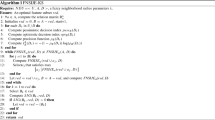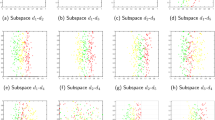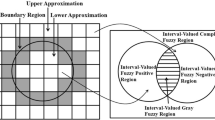Abstract
Due to the diversity and complexity of the actual data distribution, the traditional neighborhood classifier (NEC) is weak in adapting to the global data and has low utilization of local information, which leads to the degradation of the classifier's effectiveness. To adapt NEC to the differences of different dimensions in data distribution, this paper defines attribute sensitivity and improves the purity of neighborhood information granules by weighted distance. To improve the resolution of local information, this paper constructs an intuitionistic fuzzy neighborhood classifier (IFNEC) by combining NEC with the intuitionistic fuzzy set (IFS) and defines the membership degree and non-membership degree of the object in the neighborhood to depict characteristics of local data. In IFNEC, the multi-attribute decision matrix is used in the decision-making process, which is constructed by a support function and intuitionistic fuzzy aggregation operator to filter the information with large uncertainty. Finally, taking seven data sets from UCI, and using accuracy and F1-score as evaluation indicators, we conduct a comparative experiment between NEC and IFNEC. The experimental results show that IFNEC has better performance than NEC.







Similar content being viewed by others
Data availability
The datasets generated and analyzed during the current study are available from the corresponding author on reasonable request.
References
Zdzisław P (1982) Rough sets. Int J Comput Inform Sci 11(5):341–356
Lin TY (1998) Granular Computing on Binary Relations I: Data Mining and Neighborhood Systems, II: Rough Set Representations and Belief Functions, Rough Sets in Knowledge Discovery 107–140
Guoping L, Yuhua Q, Jinjin L (2012) NMGRS: neighborhood-based multigranulation rough sets. Int J Approx Reason 53(7):1080–1093
Găceanu RD, Szederjesi-Dragomir A, Pop HF, Sârbu C (2022) ABARC: An agent-based rough sets clustering algorithm. Intell Syst Appl 16:200117
Kather SB, Tripathy BK (2020) Clustering mixed data using neighbourhood rough sets. Int J Adv Intell Paradigms 15(1):1–16
Wenqian S, Yichuan H (2022) Application of rough set-neural networks in civil aviation aircraft fault data processing. J Electron Inf Sci 7(4):9–14
Maciej K, Tomasz G (2022) FPGA supported rough set reduct calculation for big datasets. J Intell Inf Syst 59(3):779–799
Xiaoling Y, Hongmei C, Tianrui L, Pengfei Z, Chuan L (2022) Student-t kernelized fuzzy rough set model with fuzzy divergence for feature selection. Inf Sci 610:52–72
Liang P, Lei D, Chin KS, Hu J (2022) Feature selection based on robust fuzzy rough sets using kernel-based similarity and relative classification uncertainty measures. Knowl-Based Syst 255:109795
Jinghua L, Lin Yaojin Du, Jixiang ZH, Ziyi C, Jia Z (2023) ASFS: a novel streaming feature selection for multi-label data based on neighborhood rough set. Appl Intell 53(2):1707–1724
Yuan M, Xu J, Li T, Sun Y (2023) Feature selection based on self-information and entropy measures for incomplete neighborhood decision systems. Complex Intell Syst 9(2):1773–1790
Weihua X, Kehua Y, Wentao Li, Weiping D (2023) An emerging fuzzy feature selection method using composite entropy-based uncertainty measure and data distribution. IEEE Trans Emerg Top Comput Intell 7(1):76–88
Tengyu Y, Hongmei C, Zhong Y, Tianrui L, Keyu L (2023) Noise-resistant multilabel fuzzy neighborhood rough sets for feature subset selection. Inf Sci 621:200–226
Hongying Z, Qianqian S, Kezhen D (2023) Information-theoretic partially labeled heterogeneous feature selection based on neighborhood rough sets. Int J Approx Reason 154:200–217
Hexiang B, Deyu L, Yong G, Jinfeng W, Feng C (2022) Spatial rough set-based geographical detectors for nominal target variables. Inf Sci 586:525–539
Hogo MA (2022) The design of academic programs using rough set association rule mining. Appl Comput Intell Soft Comput (2): 1–14
Hu Q, Yu D, Xie Z (2008) Neighborhood classifiers. Expert Syst Appl 34(2):866–876
Sihong L, Kunbin Z, Dun G, Linjie He, Yumin C (2023) An intrusion detection method based on granular autoencoders. J Intell Fuzzy Syst 44(5):8413–8424
Hailiang J, Yumin C, Liru K, Guoqiang C, Hongbo J (2022) An LVQ clustering algorithm based on neighborhood granules. J Intell Fuzzy Syst 43(5):6109–6122
Zhipeng M, Hongyue G, Lidong W (2023) A hybrid method of time series forecasting based on information granulation and dynamic selection strategy. J Intell Fuzzy Syst 44(2):2367–2379
Li F, Lu W, Yang X, Guo C (2023) Establish a trend fuzzy information granule based short-term forecasting with long-association and k-medoids clustering. Journal of Intelligent & Fuzzy Systems 44(1):1397–1411
Yangke H, Zhiming W (2020) Multi-granularity pruning for deep residual networks. J Intell Fuzzy Syst 39(5):7403–7410
Fu X, Chen Y, Yan J, Chen Y, Xu F (2023) BGRF: a broad granular random forest algorithm. J Intell Fuzzy Syst 44(5):8103–8117
Muhammad A, Anam L, Ahmad A-K (2020) Certain models of granular computing based on rough fuzzy approximations. J Intell Fuzzy Syst 39(3):2797–2816
Baoli W, Jiye L (2020) A novel preference measure for multi-granularity probabilistic linguistic term sets and its applications in large-scale group decision-making. Int J Fuzzy Syst 22(7):2350–2368
Qian J, Han X, Yu Y, Liu C (2023) Multi-granularity decision-theoretic rough sets based on the fuzzy T-equivalence relation with new strategies. J Intell Fuzzy Syst 44(4):5617–5631
Wang C, Huang Y, Shao M, Hu Q, Chen D (2020) Feature selection based on neighborhood self-information. IEEE Trans Cybern 50(9):4031–4042
Xiang L, Chao L (2022) Neighborhood rough cognitive networks. Appl Soft Comput J 131:109796
Xing Y, Kochunov P, van Erp T, Ma T, Calhoun V, Du Y (2022) A novel neighborhood rough set-based feature selection method and its application to biomarker identification of schizophrenia. IEEE J Biomed Health Inform 27:215–226
Li Z, Siyuan R, Yibo S, Xinhua Y (2023) Attribute reduction algorithm of neighborhood rough set based on supervised granulation and its application. Soft Comput 27(3):1565–1582
Liu J, Lin Y, Ding W, Zhang H, Wang C, Du J (2023) Multi-label feature selection based on label distribution and neighborhood rough set. Neurocomputing 524:142–157
An S, Guo X, Wang C, Guo G, Dai J (2023) A soft neighborhood rough set model and its applications. Inf Sci 624:185–199
González-Castro V, Debayle J, Wazaefi Y, Rahim M, Gaudy-Marqueste C, Grob JJ, Fertil B (2015) Texture descriptors based on adaptive neighborhoods for classification of pigmented skin lesions. J Electron Imaging 24(6):061104
Mera ME, Moran M (2009) Reduction of noise of large amplitude through adaptive neighborhoods. Phys Rev E 80(1):016207
Hsieh C-H, Huang P-C, Zhao Q (2018) Impulse noise replacement with adaptive neighborhood median filtering. In: International Conference on Machine Learning and Cybernetics. 2: 491–496
Atanassov KT (1986) Intuitionistic fuzzy sets. Fuzzy Sets Syst 20(1):87–96
Atanassov KT (1989) More on intuitionistic fuzzy sets. Fuzzy Sets Syst 33(1):37–45
Atanassov KT (1994) New operations defined over the intuitionistic fuzzy sets. Fuzzy Sets Syst 61(2):137–142
Dengfeng L (2005) Multiattribute decision making models and methods using intuitionistic fuzzy sets. J Comput Syst Sci 70(1):73–85
Wang G, Zhang J, Song Y, Li Q (2018) An entropy-based knowledge measure for Atanassov’s intuitionistic fuzzy sets and its application to multiple attribute decision making. Entropy 20(12):981
Xia M, Xu Z (2012) Entropy/cross entropy-based group decision making under intuitionistic fuzzy environment. Inf Fus 13:31–47
Zeshui X (2007) Intuitionistic fuzzy aggregation operators. IEEE Trans Fuzzy Syst 15(6):1179–1187
Jiang X, Zhou J, Qiao X, Peng C, Su S (2022) A neighborhood model with both distance and quantity constraints for multilabel Data. Comput Intell Neurosci 2022(1):1–10
Funding
National Natural Science Foundation of China (Grant no. 62076088),the Key Project of Natural Science Foundation of Hebei Province (No. F2023205006),and the Postgraduate Innovative Funding Project of Hebei Normal University (XCXZZSS202343).
Author information
Authors and Affiliations
Corresponding author
Additional information
Publisher's Note
Springer Nature remains neutral with regard to jurisdictional claims in published maps and institutional affiliations.
This work is supported by the National Natural Science Foundation of China (Grant No. 62076088), the Key Project of Natural Science Foundation of Hebei Province (No. F2023205006), and the Postgraduate Innovative Funding Project of Hebei Normal University (XCXZZSS202343).
Rights and permissions
Springer Nature or its licensor (e.g. a society or other partner) holds exclusive rights to this article under a publishing agreement with the author(s) or other rightsholder(s); author self-archiving of the accepted manuscript version of this article is solely governed by the terms of such publishing agreement and applicable law.
About this article
Cite this article
Yuzhang, B., Jusheng, M. Adaptive intuitionistic fuzzy neighborhood classifier. Int. J. Mach. Learn. & Cyber. 15, 1855–1871 (2024). https://doi.org/10.1007/s13042-023-02002-5
Received:
Accepted:
Published:
Issue Date:
DOI: https://doi.org/10.1007/s13042-023-02002-5




